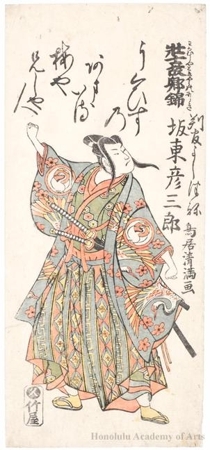Japanese Print "Bandö Hikosaburö II as Hangan Yoshitsune" by Torii Kiyomitsu
Artist:Torii Kiyomitsu
Title:Bandö Hikosaburö II as Hangan Yoshitsune
Date:1761
Details:More information...
Source:Honolulu Museum of Art
Browse all 5,476 prints...
Description:
Torii Kiyomitsu I was one of the most prominent ukiyo-e artists prior to Harunobu. Like the other artists of the Torii School, he specialized in yakusha-e (actor prints) and bijin-ga (prints depicting beautiful women). His prints are usually accompanied by a poem. This print depicts the Kabuki actor Bandö Hikosaburö II, who appeared as Högan Yoshitsune in the 1761 Ichimura-za production of the Kabuki play Waka Musha Kokyö no Nishiki (The Glorious Homecoming of a Young Warrior). The title of the play is given in the inscription along with the verse: Uguisu no / Amairu ume ya / Anija hito (My elder brother is a plum to which the warblers flock). With his arms outstretched and his head swung to the side, Hikosaburö strikes a mie, a highly theatrical pose performed by Kabuki actors, which is brilliantly captured by the artist. Despite being one of the greatest military heroes in Japanese history, Minamoto no Yoshitsune is portrayed as a pale youth with beautiful, feminine features including dazzlingly white skin and thinly penciled brows, rather than as a sturdy warrior-an image consistent with the descriptions in Gikeiki (The Chronicle of Yoshitsune), which compares Yoshitsune to the renowned Chinese beauty Yang Guifei. This is an example of a two-color print, a transitional stage in the development of full-color nishiki-e prints that was happening around this time. Kiyomitsu primarily used this technique to produce "primitive" style ukiyo-e, usually pink and green, occasionally with the addition of another color.
